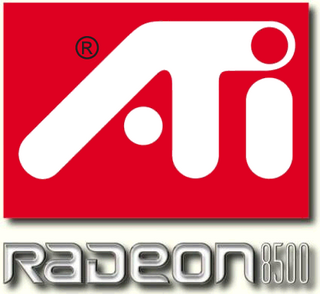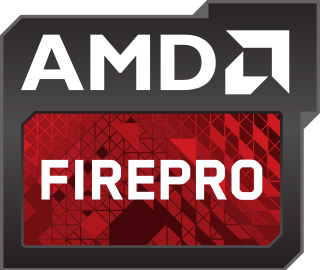
The GeForce FX or "GeForce 5" series is a line of graphics processing units from the manufacturer Nvidia.

ATI Technologies Inc. was a Canadian semiconductor technology corporation based in Markham, Ontario, that specialized in the development of graphics processing units and chipsets. Founded in 1985 as Array Technology Inc., the company listed publicly in 1993. Advanced Micro Devices (AMD) acquired ATI in 2006. As a major fabrication-less or fabless semiconductor company, ATI conducted research and development in-house and outsourced the manufacturing and assembly of its products. With the decline and eventual bankruptcy of 3dfx in 2000, ATI and its chief rival Nvidia emerged as the two dominant players in the graphics processors industry, eventually forcing other manufacturers into niche roles.
Radeon is a brand of computer products, including graphics processing units, random-access memory, RAM disk software, and solid-state drives, produced by Radeon Technologies Group, a division of Advanced Micro Devices (AMD). The brand was launched in 2000 by ATI Technologies, which was acquired by AMD in 2006 for US$5.4 billion.

The R200 is the second generation of GPUs used in Radeon graphics cards and developed by ATI Technologies. This GPU features 3D acceleration based upon Microsoft Direct3D 8.1 and OpenGL 1.3, a major improvement in features and performance compared to the preceding Radeon R100 design. The GPU also includes 2D GUI acceleration, video acceleration, and multiple display outputs. "R200" refers to the development codename of the initially released GPU of the generation. It is the basis for a variety of other succeeding products.

AMD CrossFire is a brand name for the multi-GPU technology by Advanced Micro Devices, originally developed by ATI Technologies. The technology allows up to four GPUs to be used in a single computer to improve graphics performance.

AMD FirePro was AMD's brand of graphics cards designed for use in workstations and servers running professional Computer-aided design (CAD), Computer-generated imagery (CGI), Digital content creation (DCC), and High-performance computing/GPGPU applications. The GPU chips on FirePro-branded graphics cards are identical to the ones used on Radeon-branded graphics cards. The end products differentiate substantially by the provided graphics device drivers and through the available professional support for the software. The product line is split into two categories: "W" workstation series focusing on workstation and primarily focusing on graphics and display, and "S" server series focused on virtualization and GPGPU/High-performance computing.
The R520 is a graphics processing unit (GPU) developed by ATI Technologies and produced by TSMC. It was the first GPU produced using a 90 nm photolithography process.

The R300 GPU, introduced in August 2002 and developed by ATI Technologies, is its third generation of GPU used in Radeon graphics cards. This GPU features 3D acceleration based upon Direct3D 9.0 and OpenGL 2.0, a major improvement in features and performance compared to the preceding R200 design. R300 was the first fully Direct3D 9-capable consumer graphics chip. The processors also include 2D GUI acceleration, video acceleration, and multiple display outputs.
The Radeon R700 is the engineering codename for a graphics processing unit series developed by Advanced Micro Devices under the ATI brand name. The foundation chip, codenamed RV770, was announced and demonstrated on June 16, 2008 as part of the FireStream 9250 and Cinema 2.0 initiative launch media event, with official release of the Radeon HD 4800 series on June 25, 2008. Other variants include enthusiast-oriented RV790, mainstream product RV730, RV740 and entry-level RV710.
Unified Video Decoder (UVD), previously called Universal Video Decoder, is the name given to AMD's dedicated video decoding ASIC. There are multiple versions implementing a multitude of video codecs, such as H.264 and VC-1.
The Evergreen series is a family of GPUs developed by Advanced Micro Devices for its Radeon line under the ATI brand name. It was employed in Radeon HD 5000 graphics card series and competed directly with Nvidia's GeForce 400 Series.

Sapphire Technology is a Hong Kong-based technology company, founded in 2001, which produces graphics cards for personal computers and workstations, motherboards, TV tuner cards, digital audio players and LCDTVs

The Northern Islands series is a family of GPUs developed by Advanced Micro Devices (AMD) forming part of its Radeon-brand, based on the 40 nm process. Some models are based on TeraScale 2 (VLIW5), some on the new TeraScale 3 (VLIW4) introduced with them.

The AMD Radeon R5/R7/R9 200 series is a family of GPUs developed by AMD. These GPUs are manufactured on a 28 nm Gate-Last process through TSMC or Common Platform Alliance.
The graphics processing unit (GPU) codenamed the Radeon R600 is the foundation of the Radeon HD 2000/3000 series and the FireGL 2007 series video cards developed by ATI Technologies.
The graphics processing unit (GPU) codenamed Radeon R600 is the foundation of the Radeon HD 2000 series and the FireGL 2007 series video cards developed by ATI Technologies. The HD 2000 cards competed with nVidia's GeForce 8 series.
Radeon X800 is a series of graphics cards designed by ATI Technologies Inc. introduced in May of 2004.

The R300 GPU, introduced in August 2002 and developed by ATI Technologies, is its third generation of GPU used in Radeon graphics cards. This GPU features 3D acceleration based upon Direct3D 9.0 and OpenGL 2.0, a major improvement in features and performance compared to the preceding R200 design. R300 was the first fully Direct3D 9-capable consumer graphics chip. The processors also include 2D GUI acceleration, video acceleration, and multiple display outputs.
The R200 is the second generation of GPUs used in Radeon graphics cards and developed by ATI Technologies. This GPU features 3D acceleration based upon Microsoft Direct3D 8.1 and OpenGL 1.3, a major improvement in features and performance compared to the preceding Radeon R100 design. The GPU also includes 2D GUI acceleration, video acceleration, and multiple display outputs. "R200" refers to the development codename of the initially released GPU of the generation. It is the basis for a variety of other succeeding products.











